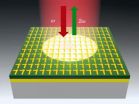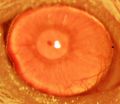(Press-News.org) Researchers at the University of Copenhagen and the Copenhagen University Hospital have identified a particular genetic mutation that may cause parkinsonism in young people. The mutation interferes with the brain's transport of the important signal substance dopamine and may also plays a role in mental diseases, e.g. ADHD. The findings have just been published in the scientific Journal of Clinical Investigation.
Being one of the most important signal substances in the brain, dopamine is particularly important for the control of movements and reward mechanisms in the brain. In the new study, Danish researchers have focused on a special protein, the dopamine transporter (DAT). DAT is a transport protein, which controls the effect of dopamine by mediating re-uptake of released dopamine from the synaptic cleft to the nerve cell. This is a very fine balance – and even small fluctuations can have major consequences for brain function:
"We can now for the first time document that mutations in the DAT-encoding gene can cause parkinsonism in young people. Furthermore, our studies show that the gene mutation is likely to contribute to the development of ADHD", explains Ulrik Gether, Professor at the Department of Neuroscience and Pharmacology, University of Copenhagen.
The researchers believe that DAT mutations may cause or predispose to the development of an entire spectrum of brain diseases – from relatively mild psychiatric diagnoses such as ADHD to serious movement disorders in infants such as Dopamine Transporter Deficiency Syndrome:
"Children born without a functional dopamine transporter develop serious movement disorders from birth, which may result in premature death. We have now identified mutations in the DAT-encoding gene as a novel cause of parkinsonism in adult patients and possibly also to complex mental disorders," says Freja H. Hansen, postdoc at the Department of Neuroscience and Pharmacology.
Genetic analysis based on one man
The scientific article, which has just been published in Journal of Clinical Investigation, is based on one patient only. Neurologists and psychiatrists have examined the male patient, who is 45 years old and has suffered from serious movement disorders since he was in his 20s. Furthermore, he has had various mental problems since childhood. When he was 36 years old, he was diagnosed with ADHD:
"It was a great relief for the patient and his family to get a genetic explanation of a disease that has affected him since childhood," says Freja H. Hansen.
But can the results be used in a wider perspective?
"We will, among other things, create a mouse model with the same genetic deficiencies, and we expect it to become a new disease model for parkinsonism and mental disorders. We hope that this will help us find new and better ways of treating these diseases," says Ulrik Gether.
"We would like to examine the frequency of mutations in the DAT-encoding gene in both children and young adults with serious movement disorders. This knowledge can clarify whether the DAT gene can be used in the genetic investigation of patients. Genetic examinations of embryos may also be relevant for some families," concludes Freja H. Hansen.
INFORMATION:
In this specific research project, the researchers at the University of Copenhagen have worked closely with the geneticists Tina Skjørringe and Lisbeth B. Møller from the Kennedy Centre at the Copenhagen University Hospital as well as with neurologist Lena E. Hjermind from the Department of Neurology also at the Copenhagen University Hospital.
Contact:
Ulrik Gether
Mobile: +45 28 75 75 48
Dopamine is an important neurotransmitter in the brain affecting physical and psychological functions such as control of movements, learning, reward, thinking and memory.
Patients with Parkinson's disease have a reduced level of dopamine in the brain and are, among other things, treated with a precursor for dopamine, the drug Levodopa. Patients suffering from mania and schizophrenia are treated with drugs that are capable of inhibiting dopamine's functions.
Dopamine is important for the brain's reward system – the more there is, the more it wants. Substances such as cocaine, speed and amphetamine increase the level of dopamine in the synapse.
Movement disorders in young people related to ADHD
2014-07-03
ELSE PRESS RELEASES FROM THIS DATE:
Hypertension, antihypertension medication, risk of psoriasis
2014-07-02
Bottom Line: Women with long-term high blood pressure (hypertension) appear to be at an increased risk for the skin condition psoriasis, and long-term use of beta (β)-blocker medication to treat hypertension may also increase the risk of psoriasis.
Author: Shaowei Wu, M.D., Ph.D., of Brown University, Providence, Rhode Island, and colleagues.
Background: Psoriasis is an immune-related chronic disease that affects about 3 percent of the U.S. population. The authors suggest prospective data on the risk of psoriasis associated with hypertension is lacking. Antihypertensive ...
Study estimates effect on surgery following national health insurance expansion
2014-07-02
Bottom Line: Full implementation of the Affordable Care Act's (ACA) national health insurance expansion could result in many more discretionary surgical procedures in the next few years based on how utilization changed after an earlier insurance reform in Massachusetts.
Author: Chandy Ellimoottil, M.D., of the University of Michigan, Ann Arbor, and colleagues.
Background: The potential effect of the ACA on surgical care is not well known. The authors examined its possible effect by analyzing the Massachusetts insurance expansion and utilization of discretionary and ...
Trial examines treatment for psychogenic nonepileptic seizures
2014-07-02
Bottom Line: A clinical trial found a reduction in seizures and improvement in related symptoms, including depression and anxiety, in patients with psychogenic nonepileptic seizures (PNES) who were treated with cognitive behavioral therapy informed psychotherapy (CBT-ip) with and without the medication sertraline.
Authors: W. Curt LaFrance, Jr., M.D., M.P.H., of Brown University, Rhode Island Hospital, Providence, R.I., and colleagues.
Background: PNES is not responsive to standard treatment and can be made worse by antiepileptic medications. Up to 20 percent of civilians ...
SDSC assists researchers in novel wildlife tracking project
2014-07-02
A team including researchers from the U.S. Geological Survey (USGS) and the San Diego Zoo's Institute for Conservation Research has developed a novel methodology that for the first time combines 3D and advanced range estimator technologies to provide highly detailed data on the range and movements of terrestrial, aquatic, and avian wildlife species.
A paper detailing the project, called 'Movement-based Estimation and Visualization of Space Use in 3D for Wildlife Ecology and Conservation', was published July 2 in the PLOS ONE online science journal. A video of the project ...
Noninvasive advanced image analysis could lead to better patient care
2014-07-02
PHOENIX, Ariz. — July 2, 2014 — Lung cancer patients could receive more precise treatment, and their progress could be better tracked, using a new high-tech method of non-invasive medical imaging analysis, according to a study published today by the journal PLOS ONE.
Genetic changes increasingly are recognized as driving cancer development. But obtaining evidence of these changes usually requires a biopsy, which can be problematic for sensitive regions of the body such as the lungs.
Based on a review of 48 patients with non-small cell lung cancer (NSCLC), the study ...
Researchers invent 'meta mirror' to help advance nonlinear optical systems
2014-07-02
Researchers at the Cockrell School of Engineering at The University of Texas at Austin have created a new nonlinear metasurface, or meta mirror, that could one day enable the miniaturization of laser systems.
The invention, called a "nonlinear mirror" by the researchers, could help advance nonlinear laser systems that are used for chemical sensing, explosives detection, biomedical research and potentially many other applications. The researchers' study will be published in the July 3 issue of Nature.
The metamaterials were created with nonlinear optical response ...
A million times better
2014-07-02
This news release is available in German.
Lasers have a fixed place in many fields of application. Yet, there are still wavelengths for which either no systems exist, or at best only large and expensive ones. On the other hand remote sensing and medical applications call for compact laser systems, for example with wavelengths from the near infrared to the Terahertz region.
A team of researchers at the Technische Universitaet Muenchen (Germany) and the University of Texas Austin (USA) has now developed a 400 nanometer thick nonlinear mirror that reflects frequency-doubled ...
Scientists can now screen for stem cells that enhance corneal regrowth
2014-07-02
A Boston-based scientific collaborative, led by Harvard Stem Cell Institute (HSCI) researchers, has discovered a way to collect the best cell type for regenerating a damaged cornea—the clear membrane that covers the pupil and directs light into the back of the eye. The investigators report in the journal Nature that purified human stem cells can be used to improve long-term vision in mice. The team is now pursuing FDA-approval for the technique before moving on to patient clinical trials.
The study, lead by co-senior investigators Natasha Frank, MD, and Markus Frank, ...
Die-offs of band-tailed pigeons connected to newly discovered parasite
2014-07-02
A new pathogen has been discovered by scientists investigating major
die-offs of pigeons native to North America, according to studies led
by the University of California, Davis, and the California Department
of Fish and Wildlife.
Scientists were able to implicate this new parasite, along with the
ancient parasite Trichomonas gallinae, in the recent deaths of
thousands of Pacific Coast band-tailed pigeons. The die-offs occurred
during multiple epidemics in California's Central Coast and Sierra
Nevada mountain ranges. Scientists named the new pathogen Trichomonas
stableri.
Avian ...
Computer-automated, time-lapse embryo photography may increase success of IVF
2014-07-02
PHILADELPHIA - Using computer-automated, time‐lapse photography of embryos in the laboratory during in-vitro fertilization may improve embryo selection, potentially increasing the chances of pregnancy among women undergoing the procedure, according to new research from the Perelman School of Medicine at the University of Pennsylvania and five other fertility centers. Results of the study were presented this week at the 30th annual European Society of Human Reproduction and Embryology (ESHRE) meeting in Munich, Germany.
The researchers at Penn and their collaborators ...



